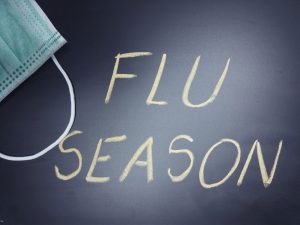Categories
Most Recent
Giving viruses the cold shoulder
4th Dec 2023 in Dental, Animal Health, HealthcareInfection control is seamlessly integrated within everyday life in your practice. Every member of the team has a role to play in protecting themselves, their patients and their colleagues from the risk of infection. To achieve the highest standards of infection prevention, professionals must meticulously follow practice protocols and have access to equipment they can rely on.
This is a particularly important topic as we enter the colder months of the year, as the risk of viral transmission increases at this time. Looking at influenza as an example, winter tends to be a difficult time for people who are most susceptible to the virus, including pregnant women, children under 5, elderly people and individuals with chronic medical or immunosuppressive conditions.[i]
Preparing for the spike
The UK Health Security Agency monitors the prevalence of respiratory viruses from October to May – the months when influenza is typically at its highest.[ii] The weekly reports consistently demonstrate spikes in influenza-related hospital admission rates and GP consultations between November and the following January from 2015 to 2019.[iii] Covid-19 was more prolific than influenza in recent winters, although the latter seems to be making a return as of winter 2022-23, with cases of both viruses recently confirmed across the UK.[iv]
Environmental impact on viruses
Many respiratory viruses spread between people via aerosol or contact with pathogens. Droplets are exhaled by an infected host and then evaporate into the air ready to either be inhaled by another unsuspecting person or fall onto surfaces.
There are several reasons why the rates of sickness tend to increase in the winter months. When it comes to respiratory viruses,
three potential factors are  believed to contribute to this phenomenon:[v] virus stability in environmental conditions, human behaviours and environmental impact on host immune systems.
believed to contribute to this phenomenon:[v] virus stability in environmental conditions, human behaviours and environmental impact on host immune systems.
With regards to the temperature and humidity of the air, influenza has been shown to remain most stable and viable in lower temperatures and lower humidity.[vi] This reflects the temperatures often experienced in non-tropical climates in the winter months.
Human behaviour exacerbates the situation, with the colder weather driving people indoors for longer periods of time. More crowding indoors and greater chance of contact with other people may increase the risk of viral infection.[vii]
In addition, the change in environmental conditions has been shown to affect humans in a way that influences viral transmission rates as well. For example, the nasal epithelium is cooled when a person inhales cold air, which in turn has been shown to hinder mucociliary clearance and lower the body’s natural defences.[viii]
Protection in the dental practice
Of course, influenza is not the only virus to pose a threat in the dental practice. Others may include norovirus (the infamous winter vomiting bug), hepatitis B, C and D, HIV, measles, mumps, rubella and Covid-19.[ix] It is therefore vital that any infection prevention protocols put in place would be effective against all of these, as well as bacteria, fungi and spores.
While outdoor environmental factors cannot be controlled, there are still many things that the dental team can do to minimise the risk of spreading infection in the practice. For example, good ventilation can help to reduce airborne transmission.[x] Frequent hand hygiene has been shown to significantly lower the risk of viral infection too, as has reduced touching of the eyes, nose and mouth.[xi] In addition, it is essential to routinely clean and disinfect surfaces throughout the practice, as influenza can survive on hard non-porous surfaces for 24-48 hours and on textiles or paper for 8-12 hours.[xii]
Another crucial part of the infection control workflow to prevent the transmission of all pathogens in the dental practice is instrument sterilisation using an appropriate autoclave.
The Little Sister range of vacuum and non-vacuum autoclaves from Eschmann provides easy-to-use, highly reliable and durable solutions that suit the needs of every practice.
Eschmann has used its 60+ years of experience in autoclave design and manufacture to develop the latest models, which are available in a variety of capacities, including 11, 17 and 23 litres. The USB cycle data recorder, and option to upgrade to the wireless Autolog cycle data manager also facilitate seamless digitised record keeping.
All equipment from Eschmann can be supported by the Eschmann Care & Cover service package, providing Annual Validation and Pressure Vessel Certification, Annual Service and Software Upgrades, Unlimited Breakdown Cover, Unlimited Eschmann Parts and Labour and on-site support from 50+ Eschmann engineersnationwide, as well as Enhanced CPD User training and technical telephone support.
Stay safe this winter
The risk of illness increases in the winter so it is a good time to review and further optimise already meticulous infection control protocols in the dental practice. Several viruses pose a threat to patients and staff alike, but professionals can help keep everyone safe by following some simple yet essential steps every day.
For more information on the highly effective and affordable range of infection control products from Eschmann, please contact us.
[i] World Health Organization. Influenza (seasonal) January 2023. https://www.who.int/news-room/fact-sheets/detail/influenza-(seasonal) [Accessed August 2023]
[ii] UK Health Security Agency. Surveillance of influenza and other seasonal respiratory viruses in winter 2021 to 2022. Updated July 2023. https://www.gov.uk/government/statistics/annual-flu-reports/surveillance-of-influenza-and-other-seasonal-respiratory-viruses-in-winter-2021-to-2022#:~:text=The%202021%20to%202022%20season%20saw%20an%20increase%20in%20the,compared%20to%20pre%2Dpandemic%20seasons. [Accessed August 20323].
[iii] Weekly national flu reports: 2013 to 2014 season. 2014 to 2015 season. 2015 to 2016 season, 2016 to 2017 season. 2017 to 2018 season. 2018 to 2019 season. Gov.uk https://www.gov.uk/government/statistics/weekly-national-flu-reports-2013-to-2014-season [Accessed August 2023]
[iv] National flu and COVID-19 surveillance report: 26 January 2023. Gov.uk https://www.gov.uk/government/statistics/national-flu-and-covid-19-surveillance-reports-2022-to-2023-season[Accessed August 2023]
[v] Neumann G, Kawaoka Y. Seasonality of influenza and other respiratory viruses. EMBO Molecular Medicine. 2022; 14: e15352 doi.org/10.15252/emmm.202115352
[vi] Lowen AC, Steel J. Roles of humidity and temperature in shaping influenza seasonality. J Virol. 2014 Jul;88(14):7692-5. doi: 10.1128/JVI.03544-13. Epub 2014 Apr 30. PMID: 24789791; PMCID: PMC4097773.
[vii] Valle SYD, Mniszewski SM, Hyman JM. Modeling the Impact of Behavior Changes on the Spread of Pandemic Influenza. Modeling the Interplay Between Human Behavior and the Spread of Infectious Diseases. 2012 Oct 29:59–77. doi: 10.1007/978-1-4614-5474-8_4. PMCID: PMC7114992.
[viii] Eccles R. An explanation for the seasonality of acute upper respiratory tract viral infections. Acta Otolaryngol. 2002 Mar;122(2):183-91. doi: 10.1080/00016480252814207. PMID: 11936911.
[ix] Volgenant CMC, de Soet JJ. Cross-transmission in the Dental Office: Does This Make You Ill? Curr Oral Health Rep. 2018;5(4):221-228. doi: 10.1007/s40496-018-0201-3. Epub 2018 Oct 25. PMID: 30524929; PMCID: PMC6244620.
[x] Jendrossek SN, Jurk LA, Remmers K, Cetin YE, Sunder W, Kriegel M, Gastmeier P. The Influence of Ventilation Measures on the Airborne Risk of Infection in Schools: A Scoping Review. Int J Environ Res Public Health. 2023 Feb 20;20(4):3746. doi: 10.3390/ijerph20043746. PMID: 36834438; PMCID: PMC9961295.
[xi] Liu M, Ou J, Zhang L, Shen X, Hong R, Ma H, Zhu BP, Fontaine RE. Protective Effect of Hand-Washing and Good Hygienic Habits Against Seasonal Influenza: A Case-Control Study. Medicine (Baltimore). 2016 Mar;95(11):e3046. doi: 10.1097/MD.0000000000003046. PMID: 26986125; PMCID: PMC4839906.
[xii] Bean B, Moore BM, Sterner B, Peterson LR, Gerding DN, Balfour HH Jr. Survival of influenza viruses on environmental surfaces. J Infect Dis. 1982 Jul;146(1):47-51. doi: 10.1093/infdis/146.1.47. PMID: 6282993.
[xiii] World Health Organization. Influenza (seasonal) January 2023. https://www.who.int/news-room/fact-sheets/detail/influenza-(seasonal) [Accessed August 2023]
[xiv] UK Health Security Agency. Surveillance of influenza and other seasonal respiratory viruses in winter 2021 to 2022. Updated July 2023. https://www.gov.uk/government/statistics/annual-flu-reports/surveillance-of-influenza-and-other-seasonal-respiratory-viruses-in-winter-2021-to-2022#:~:text=The%202021%20to%202022%20season%20saw%20an%20increase%20in%20the,compared%20to%20pre%2Dpandemic%20seasons. [Accessed August 20323].
[xv] Weekly national flu reports: 2013 to 2014 season. 2014 to 2015 season. 2015 to 2016 season, 2016 to 2017 season. 2017 to 2018 season. 2018 to 2019 season. Gov.uk https://www.gov.uk/government/statistics/weekly-national-flu-reports-2013-to-2014-season [Accessed August 2023]
[xvi] National flu and COVID-19 surveillance report: 26 January 2023. Gov.uk https://www.gov.uk/government/statistics/national-flu-and-covid-19-surveillance-reports-2022-to-2023-season[Accessed August 2023]
[xvii] Neumann G, Kawaoka Y. Seasonality of influenza and other respiratory viruses. EMBO Molecular Medicine. 2022; 14: e15352 doi.org/10.15252/emmm.202115352
[xviii] Lowen AC, Steel J. Roles of humidity and temperature in shaping influenza seasonality. J Virol. 2014 Jul;88(14):7692-5. doi: 10.1128/JVI.03544-13. Epub 2014 Apr 30. PMID: 24789791; PMCID: PMC4097773.
[xix] Valle SYD, Mniszewski SM, Hyman JM. Modeling the Impact of Behavior Changes on the Spread of Pandemic Influenza. Modeling the Interplay Between Human Behavior and the Spread of Infectious Diseases. 2012 Oct 29:59–77. doi: 10.1007/978-1-4614-5474-8_4. PMCID: PMC7114992.
[xx] Eccles R. An explanation for the seasonality of acute upper respiratory tract viral infections. Acta Otolaryngol. 2002 Mar;122(2):183-91. doi: 10.1080/00016480252814207. PMID: 11936911.
[xxi] Volgenant CMC, de Soet JJ. Cross-transmission in the Dental Office: Does This Make You Ill? Curr Oral Health Rep. 2018;5(4):221-228. doi: 10.1007/s40496-018-0201-3. Epub 2018 Oct 25. PMID: 30524929; PMCID: PMC6244620.
[xxii] Jendrossek SN, Jurk LA, Remmers K, Cetin YE, Sunder W, Kriegel M, Gastmeier P. The Influence of Ventilation Measures on the Airborne Risk of Infection in Schools: A Scoping Review. Int J Environ Res Public Health. 2023 Feb 20;20(4):3746. doi: 10.3390/ijerph20043746. PMID: 36834438; PMCID: PMC9961295.
[xxiii] Liu M, Ou J, Zhang L, Shen X, Hong R, Ma H, Zhu BP, Fontaine RE. Protective Effect of Hand-Washing and Good Hygienic Habits Against Seasonal Influenza: A Case-Control Study. Medicine (Baltimore). 2016 Mar;95(11):e3046. doi: 10.1097/MD.0000000000003046. PMID: 26986125; PMCID: PMC4839906.
[xxiv] Bean B, Moore BM, Sterner B, Peterson LR, Gerding DN, Balfour HH Jr. Survival of influenza viruses on environmental surfaces. J Infect Dis. 1982 Jul;146(1):47-51. doi: 10.1093/infdis/146.1.47. PMID: 6282993.









